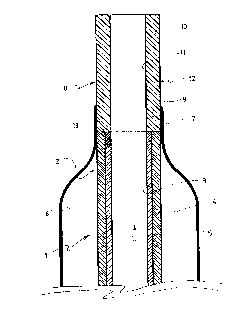Some of the information on this Web page has been provided by external sources. The Government of Canada is not responsible for the accuracy, reliability or currency of the information supplied by external sources. Users wishing to rely upon this information should consult directly with the source of the information. Content provided by external sources is not subject to official languages, privacy and accessibility requirements.
Any discrepancies in the text and image of the Claims and Abstract are due to differing posting times. Text of the Claims and Abstract are posted:
| (12) Patent: | (11) CA 2173914 |
|---|---|
| (54) English Title: | INTERVENTIONAL CATHETER |
| (54) French Title: | CATHETER POUR INTERVENTIONS |
| Status: | Expired and beyond the Period of Reversal |
| (51) International Patent Classification (IPC): |
|
|---|---|
| (72) Inventors : |
|
| (73) Owners : |
|
| (71) Applicants : | |
| (74) Agent: | SMART & BIGGAR LP |
| (74) Associate agent: | |
| (45) Issued: | 1999-02-16 |
| (22) Filed Date: | 1996-04-11 |
| (41) Open to Public Inspection: | 1996-11-06 |
| Examination requested: | 1996-04-11 |
| Availability of licence: | N/A |
| Dedicated to the Public: | N/A |
| (25) Language of filing: | English |
| Patent Cooperation Treaty (PCT): | No |
|---|
| (30) Application Priority Data: | ||||||
|---|---|---|---|---|---|---|
|
An interventional catheter for angioplasty and the like,
comprising a catheter tube (1) formed of two superposed
layers 3 and 4 of materials different from one another.
Over the distal end 2 of the catheter tube 1 is
positioned a balloon 6 with a distal neck 7 sealingly
surrounding the outer layer 4 of the catheter tube. A
tip 8 is formed by a piece of material 12 welded to the
distal end 2 of the catheter tube and the distal neck 7
of the balloon 6 also welds to the proximal portion 9 of
the tip 8.
Cathéter d'intervention servant, notamment, pour les angioplasties. Il comprend un tube (1) formé de deux couches superposées (3 et 4) de matières différentes. A l'extrémité distale (2) du tube de cathéter (1) est placé un ballonnet (6) ayant un col distal (7) entourant de façon étanche la couche extérieure (4) du tube de cathéter. Une pointe (8) est formée d'une pièce de matière (12) soudée à l'extrémité distale (2) du tube de cathéter, et le col distal (7) du ballonnet (6) est également soudé à la partie proximale (9) de la pointe (8).
Note: Claims are shown in the official language in which they were submitted.
Note: Descriptions are shown in the official language in which they were submitted.

2024-08-01:As part of the Next Generation Patents (NGP) transition, the Canadian Patents Database (CPD) now contains a more detailed Event History, which replicates the Event Log of our new back-office solution.
Please note that "Inactive:" events refers to events no longer in use in our new back-office solution.
For a clearer understanding of the status of the application/patent presented on this page, the site Disclaimer , as well as the definitions for Patent , Event History , Maintenance Fee and Payment History should be consulted.
| Description | Date |
|---|---|
| Inactive: IPC deactivated | 2015-08-29 |
| Inactive: IPC assigned | 2015-04-29 |
| Inactive: First IPC assigned | 2015-04-29 |
| Inactive: IPC removed | 2015-04-29 |
| Inactive: IPC assigned | 2015-04-29 |
| Inactive: IPC expired | 2013-01-01 |
| Inactive: IPC from MCD | 2006-03-12 |
| Time Limit for Reversal Expired | 2002-04-11 |
| Letter Sent | 2001-04-11 |
| Grant by Issuance | 1999-02-16 |
| Letter Sent | 1998-11-30 |
| Amendment After Allowance Requirements Determined Compliant | 1998-11-30 |
| Amendment After Allowance (AAA) Received | 1998-11-16 |
| Pre-grant | 1998-11-02 |
| Inactive: Final fee received | 1998-11-02 |
| Amendment After Allowance (AAA) Received | 1998-11-02 |
| Inactive: Amendment after Allowance Fee Processed | 1998-11-02 |
| Letter Sent | 1998-08-27 |
| Notice of Allowance is Issued | 1998-08-27 |
| Notice of Allowance is Issued | 1998-08-27 |
| Inactive: Approved for allowance (AFA) | 1998-08-07 |
| Inactive: Application prosecuted on TS as of Log entry date | 1998-04-23 |
| Inactive: Status info is complete as of Log entry date | 1998-04-23 |
| Inactive: Multiple transfers | 1998-03-11 |
| Application Published (Open to Public Inspection) | 1996-11-06 |
| Request for Examination Requirements Determined Compliant | 1996-04-11 |
| All Requirements for Examination Determined Compliant | 1996-04-11 |
There is no abandonment history.
The last payment was received on 1998-03-04
Note : If the full payment has not been received on or before the date indicated, a further fee may be required which may be one of the following
Please refer to the CIPO Patent Fees web page to see all current fee amounts.
| Fee Type | Anniversary Year | Due Date | Paid Date |
|---|---|---|---|
| Request for examination - standard | 1996-04-11 | ||
| MF (application, 2nd anniv.) - standard | 02 | 1998-04-14 | 1998-03-04 |
| Registration of a document | 1998-03-11 | ||
| Final fee - standard | 1998-11-02 | ||
| 1998-11-02 | |||
| MF (patent, 3rd anniv.) - standard | 1999-04-12 | 1999-02-19 | |
| MF (patent, 4th anniv.) - standard | 2000-04-11 | 2000-04-05 |
Note: Records showing the ownership history in alphabetical order.
| Current Owners on Record |
|---|
| SCHNEIDER (EUROPE) GMBH |
| Past Owners on Record |
|---|
| JAN FEHSE |
| MATHIAS HELLER |